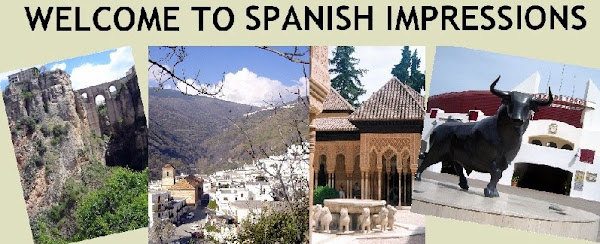- an article by Robert Bovington
The Alcazaba is an enormous fortress that dominates the city of Almería, standing as it does on a hill overlooking the town and the sea. It was built in the tenth century but over the centuries it has had further enhancements added such as a Moorish palace and, in the time of the Catholic Kings, a Christian palace.
Bougainvillea, prickly pear, aloe vera, mimosa, and jasmine tumble down the slopes near the entrance. There are also gardens within the grounds of the citadel both formal and informal. Poplar, willow, rose bushes and lavender are just some of the flora to be found within.
I enjoy walking around the grounds of the Alcazaba and exploring the towers and battlements - especially as I don't have to pay to get in! Entrance to the fortress is free to EU Nationals - just remember to take your passport. The leaflet provided at the entrance kiosk is headed 'Monumental Site Alcazaba de Almería' - a pretty good description because the 'Alcazaba' really is both monumental in size and, I think, monumental in appearance.
It is hard to believe that its construction was started over a hundred years before William the Conqueror invaded Britain. The actual date that Abd al-Rahman - the first caliph of Al-Andalus - ordered its construction was 955.

There's a lot to see in the various enclosures of the Alcazaba.
In the first enclosure there are pleasant gardens comprising some formal landscaping - manicured hedges of conifer enclosing a pond that is fed by an acequia. A mimosa tree stands guard providing the pool with shade. There are trimmed hedges enclosing rose bushes that run parallel with the battlement walls.
From the walls there are impressive views of the old Moorish houses below and the port in the distance. At the end of the formal gardens, which include pine trees, and beds of lavender, there is a building called 'Baluarte de Saliente' which literally means 'Projecting Bastion'. In the 10th century the old walls, which enclosed the city, started from here before making their way to the sea.
From the battlements on the northern side of the garden, there are spectacular views of the 'Muralla de Jayrán' - the walls that were built to enlarge the city's defences in the 11th century. They run all the way to the 'Cerro de San Cristóbal' - the hill of Saint Christopher.
The gardens are still impressive on this side of the first enclosure with more manicured hedges enclosing rose bushes and pomegranate trees. Nearer the top of this area, the formal gardens gives way to palm, prickly pear and mimosa.
On the 'Wall of the Watchtower' stands an impressive bell tower. The bell was used to warn people of attacking pirates.
At the entrance to the second enclosure, a mighty mimosa tree provides shade for the goldfish swimming around in the pond next to the doorway.
The second enclosure originally housed the royal residence and contained all the most important buildings including houses, baths and the mosque. Most have been destroyed but there is still plenty to see.
Just inside the second enclosure, there is a beautiful enclosed garden containing a number of tropical plants. Manicured bushes and trees surround a pond and a fountain is located at the far end.
I would recommend visitors to visit the towers of the Alcazaba. From 'Torre Norte' there are spectacular views of the walls of Jayrán and, in my view, even more impressive panoramas can be seen from 'Torre Sur'. Southeasterly the Cabo de Gata can be seen in the distance. Southwest is the 'Castillo de San Telmo', Almería's lighthouse standing proudly on a rocky outcrop. These towers are great vantage points for viewing much of the city below. Visitors might even notice a ferry pulling out of the harbour and wonder whether its passengers are bound for Morocco, Algeria or the Spanish enclave of Melilla.
On leaving the towers, visitors will encounter another little garden that mostly contains dwarf palms and cactus type plants with a tall eucalyptus tree hovering over them.
Most of the second enclosure is in ruins and, on my last visit, I had to walk to the third enclosure by way of a cordoned off walkway. This area between the garden of dwarf palms and the third sector is enormous - big enough to hold an army. It actually holds the foundations of palaces, houses, baths and probably much more. Several workers are employed there, some renovating and some, I believe, are archaeologists unearthing more treasures. One such important relic is the private baths of the 'Hammam Palace'. I know this because a placard had been thoughtfully erected nearby.
In the third enclosure, at the very top of the hill, is an impressive parade ground. Parapets and towers surround a large paved area. One of the towers, 'Torre de Homenaje', has the coat of arms of the 'Catholic Monarchs' above the doorway. It was Ferdinand and Isabella who ordered the construction of this, the castle part of the 'Alcazaba'.
In the 'Torre de la Pólvora' - the tower of gunpowder - there are cannon. One of them was pointing seaward. Pirates do not invade Almería anymore but the province does get its fair share of illegal immigrants especially from Morocco!
© 2010 Robert Bovington. All rights reserved.
also by Robert Bovington
“SPANISH IMPRESSIONS” (ISBN 978-1-4452-2543-2)
“SPANISH MATTERS” (ISBN 978-1-4452-0773-5)











